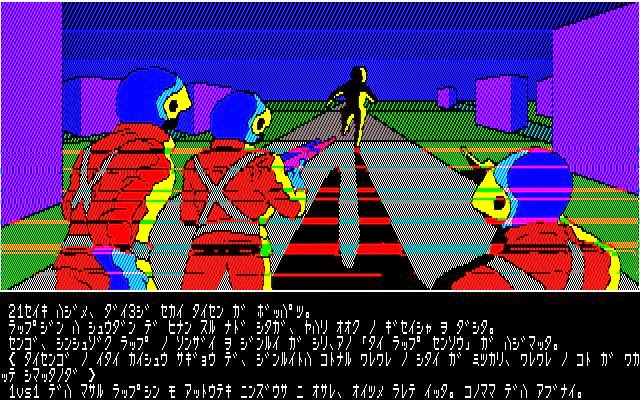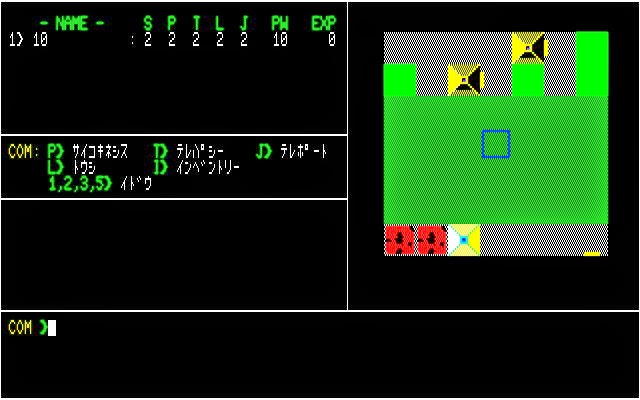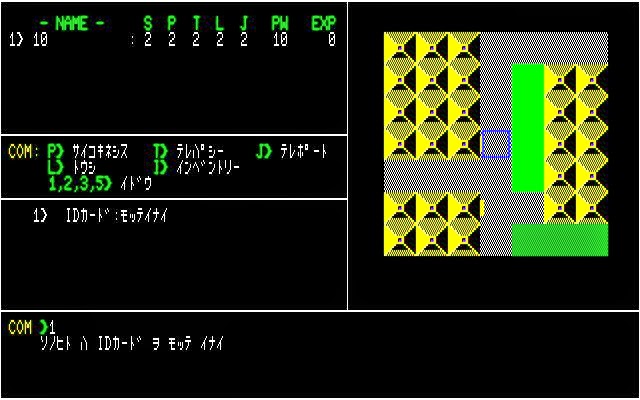Evidently Chaos was initially conceived as a card game and it definitely feels like it. To start, your character is always given a random set of magic spells, akin to drawing them from a pool of cards, that can only be used once. The battlefield could easily be replicated on a small mat, and one of the menu options is even labelled "examine board". It was even published by Games Workshop, recognized for their popular Warhammer series of strategy board games.
The rules aren't particularly complicated. You select between 2-8 players, determine who will be player or computer-controlled, and get dropped into the action. There are four options: to examine spells, select a spell, examine the board, and continue the game. You get more cards/spells based on how many wizards start on the field. After a spell cast, you get to move your characters around and attack. The only complicated aspect of the entire game is the concept of law and chaos.
Certain creatures are lawful and others are chaotic. If more of a certain kind are on the board, it becomes easier to cast any spell of that type. Basically, if everything on the board is a lawful snake, you're only going to have a 10% chance to conjure a vampire bat. This can greatly alter your approach to battle, and if you're stuck with mostly chaotic spells while everyone else has lawful, you're largely screwed.
My first time through, I opted to keep things simple with two wizards. We face off on a very large map. There are eight separate avatar icons that you can make a variety of colors, but my personal favorite is the raising-the-roof pink guy on the left.
I cast a skeleton, a snake, and a slime, while my opponent sends out an ogre. Slimes slowly spread to surroundings spaces and are meant to be used near an opponent that they will attack, but not knowing this early on, I wind up placing it way too far away. It never comes close to my opponent, but in a big eight man brawl, it can be vital.
Eventually, I conjure a vampire that beats the wizard to a pulp. Undead characters cannot be hit with physical attacks, which is all the wizard has left at this juncture. The wizard manages to conjure a monster to aid him after a turn or so, but he also only has physical offense. My vampire quickly and unceremoniously wins the bout.
Four to eight wizard battles quickly become complicated. Gorillas, eagles, horses, and unicorns flood the screen, and enough monsters can get summoned that every player will have enough representatives to literally attack everyone all at once. It's easily one of the most enjoyable tactical strategy games I've ever played, although I want to check out X-Com Apocalypse and Gollop's other Spectrum games before making any brash "best game ever" statements.
I tried another ZX Spectrum game called Skool Daze, which wound up being far less intuitive. I'm in a three story building that has some classrooms, and if I use the jump button too much, someone tells me that I'm not a kangaroo and the "lines" number on the bottom rihgt goes up. When I find out some more information, I'll let you know.
Yesterday, I wound up going not just to one game store, but two. The first is Game Headz, where I found a dozen unpriced games that I wanted. Interestingly enough, the two labelled games I wanted were actually mispriced, thankfully lower than the tag. Of the fourteen games, I wound up buying two: Tombs and Treasures and Totally Rad on NES. The guy told me Kung Fu Kid for Master System wasn't even in the computer, so he gave it to me for free. I usually don't frequent this store because of it's higher prices, but if they make freebies a habit, I'm definitely going back.
At Flipside Records, I found Crypt Killer on PS1 for three bucks, which I quickly snatched. I also grabbed three handheld games, Chicago Syndicate for Game Gear, Roswell Conspiracies for Game Boy Color, and Shaman King for Game Boy Advance. My girlfriend instantly wanted Roswell Conspiracies due to her interest in conspiracies in general, but I was surprised by how enjoyable it was. I intend on going back to it, but right now, I'm off to play my NES acquisitions.





























































